Development of Mobile Application for Online Stationary Shopping
VerifiedAdded on 2023/06/08
|89
|19534
|95
Project
AI Summary
This research paper outlines the development of an Android application for online stationary shopping, featuring both user and admin functionalities. The user-end application allows customers to purchase stationary goods, while the admin-end enables product management and order processing. The app aims to provide a secure and user-friendly interface, employing encryption and SQL injection prevention to mitigate security risks. The development process includes requirement analysis, design using UML diagrams, implementation in Java with an SQLite database, and thorough testing. The paper also evaluates the application's performance and addresses legal, social, ethical, and professional considerations. The goal is to create a cost-effective solution that enhances brand loyalty and provides a seamless online shopping experience for customers with low internet connectivity.
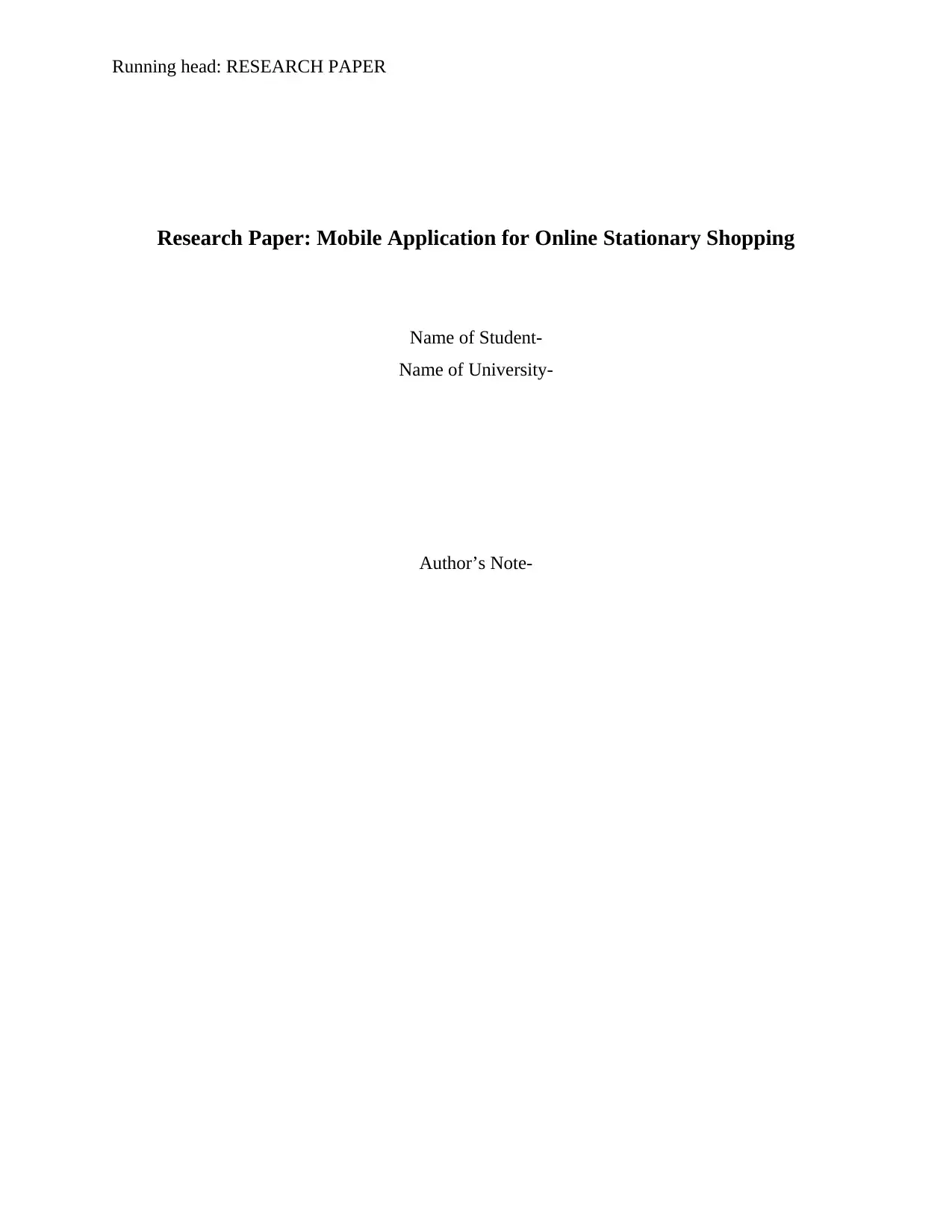
Running head: RESEARCH PAPER
Research Paper: Mobile Application for Online Stationary Shopping
Name of Student-
Name of University-
Author’s Note-
Research Paper: Mobile Application for Online Stationary Shopping
Name of Student-
Name of University-
Author’s Note-
Paraphrase This Document
Need a fresh take? Get an instant paraphrase of this document with our AI Paraphraser
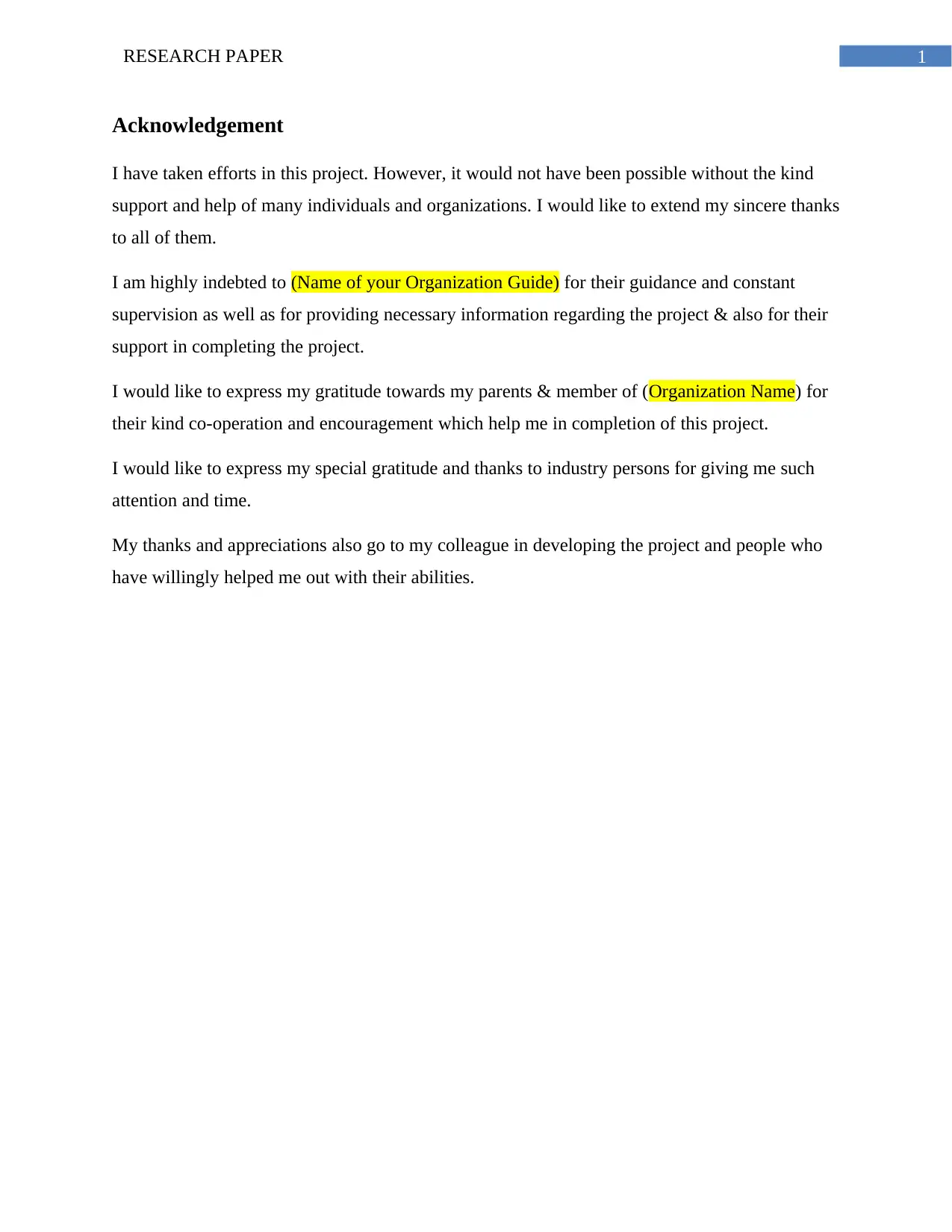
1RESEARCH PAPER
Acknowledgement
I have taken efforts in this project. However, it would not have been possible without the kind
support and help of many individuals and organizations. I would like to extend my sincere thanks
to all of them.
I am highly indebted to (Name of your Organization Guide) for their guidance and constant
supervision as well as for providing necessary information regarding the project & also for their
support in completing the project.
I would like to express my gratitude towards my parents & member of (Organization Name) for
their kind co-operation and encouragement which help me in completion of this project.
I would like to express my special gratitude and thanks to industry persons for giving me such
attention and time.
My thanks and appreciations also go to my colleague in developing the project and people who
have willingly helped me out with their abilities.
Acknowledgement
I have taken efforts in this project. However, it would not have been possible without the kind
support and help of many individuals and organizations. I would like to extend my sincere thanks
to all of them.
I am highly indebted to (Name of your Organization Guide) for their guidance and constant
supervision as well as for providing necessary information regarding the project & also for their
support in completing the project.
I would like to express my gratitude towards my parents & member of (Organization Name) for
their kind co-operation and encouragement which help me in completion of this project.
I would like to express my special gratitude and thanks to industry persons for giving me such
attention and time.
My thanks and appreciations also go to my colleague in developing the project and people who
have willingly helped me out with their abilities.
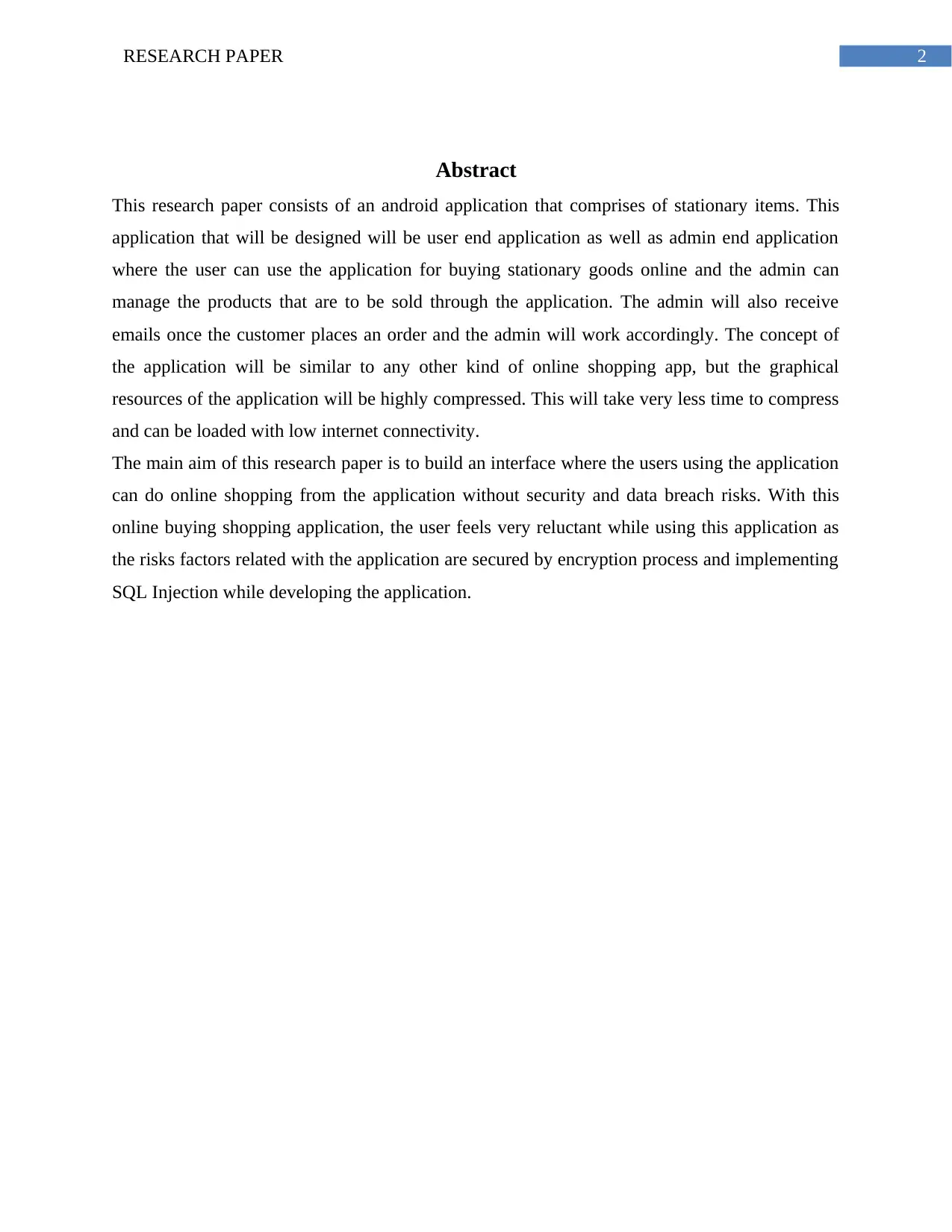
2RESEARCH PAPER
Abstract
This research paper consists of an android application that comprises of stationary items. This
application that will be designed will be user end application as well as admin end application
where the user can use the application for buying stationary goods online and the admin can
manage the products that are to be sold through the application. The admin will also receive
emails once the customer places an order and the admin will work accordingly. The concept of
the application will be similar to any other kind of online shopping app, but the graphical
resources of the application will be highly compressed. This will take very less time to compress
and can be loaded with low internet connectivity.
The main aim of this research paper is to build an interface where the users using the application
can do online shopping from the application without security and data breach risks. With this
online buying shopping application, the user feels very reluctant while using this application as
the risks factors related with the application are secured by encryption process and implementing
SQL Injection while developing the application.
Abstract
This research paper consists of an android application that comprises of stationary items. This
application that will be designed will be user end application as well as admin end application
where the user can use the application for buying stationary goods online and the admin can
manage the products that are to be sold through the application. The admin will also receive
emails once the customer places an order and the admin will work accordingly. The concept of
the application will be similar to any other kind of online shopping app, but the graphical
resources of the application will be highly compressed. This will take very less time to compress
and can be loaded with low internet connectivity.
The main aim of this research paper is to build an interface where the users using the application
can do online shopping from the application without security and data breach risks. With this
online buying shopping application, the user feels very reluctant while using this application as
the risks factors related with the application are secured by encryption process and implementing
SQL Injection while developing the application.
⊘ This is a preview!⊘
Do you want full access?
Subscribe today to unlock all pages.

Trusted by 1+ million students worldwide
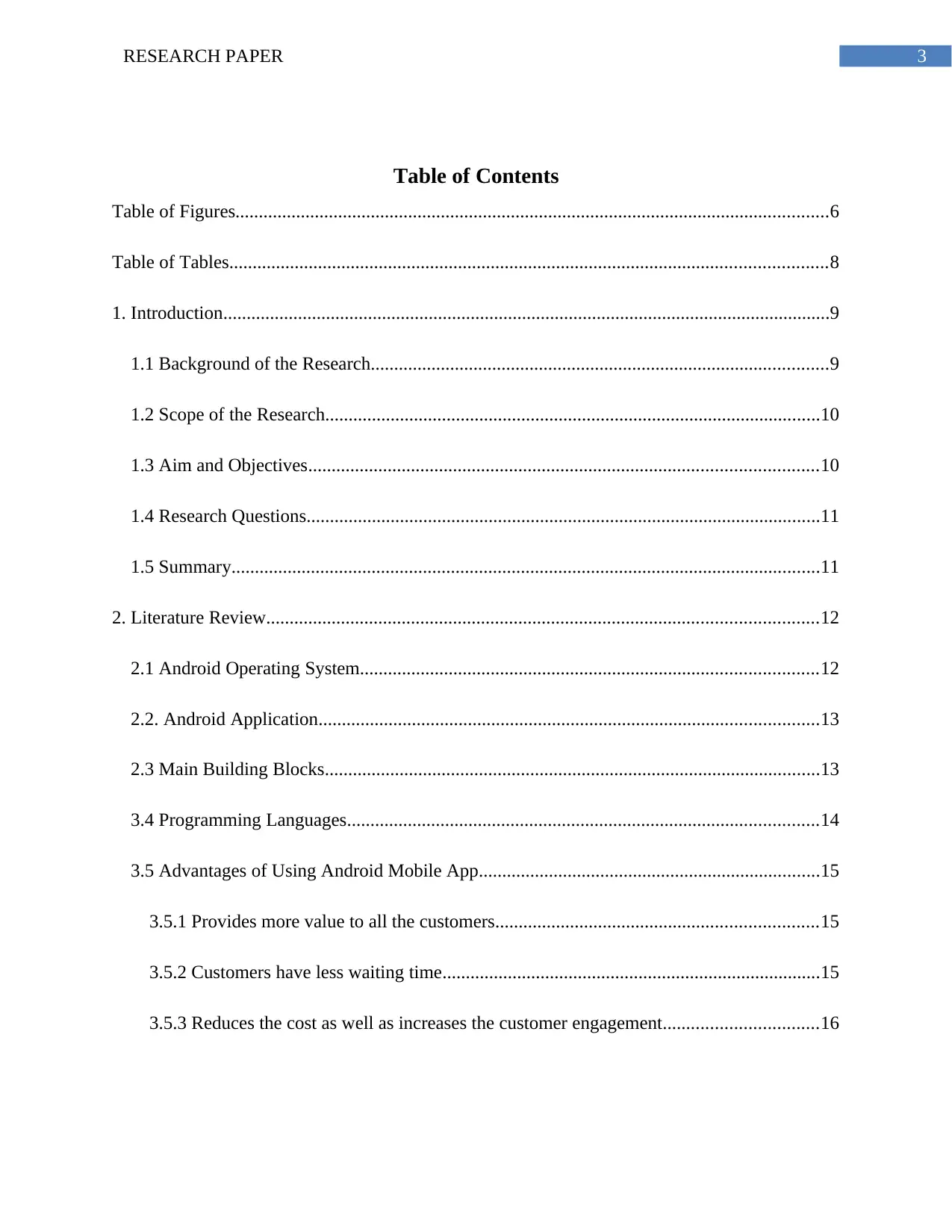
3RESEARCH PAPER
Table of Contents
Table of Figures...............................................................................................................................6
Table of Tables................................................................................................................................8
1. Introduction..................................................................................................................................9
1.1 Background of the Research..................................................................................................9
1.2 Scope of the Research..........................................................................................................10
1.3 Aim and Objectives.............................................................................................................10
1.4 Research Questions..............................................................................................................11
1.5 Summary..............................................................................................................................11
2. Literature Review......................................................................................................................12
2.1 Android Operating System..................................................................................................12
2.2. Android Application...........................................................................................................13
2.3 Main Building Blocks..........................................................................................................13
3.4 Programming Languages.....................................................................................................14
3.5 Advantages of Using Android Mobile App.........................................................................15
3.5.1 Provides more value to all the customers.....................................................................15
3.5.2 Customers have less waiting time.................................................................................15
3.5.3 Reduces the cost as well as increases the customer engagement.................................16
Table of Contents
Table of Figures...............................................................................................................................6
Table of Tables................................................................................................................................8
1. Introduction..................................................................................................................................9
1.1 Background of the Research..................................................................................................9
1.2 Scope of the Research..........................................................................................................10
1.3 Aim and Objectives.............................................................................................................10
1.4 Research Questions..............................................................................................................11
1.5 Summary..............................................................................................................................11
2. Literature Review......................................................................................................................12
2.1 Android Operating System..................................................................................................12
2.2. Android Application...........................................................................................................13
2.3 Main Building Blocks..........................................................................................................13
3.4 Programming Languages.....................................................................................................14
3.5 Advantages of Using Android Mobile App.........................................................................15
3.5.1 Provides more value to all the customers.....................................................................15
3.5.2 Customers have less waiting time.................................................................................15
3.5.3 Reduces the cost as well as increases the customer engagement.................................16
Paraphrase This Document
Need a fresh take? Get an instant paraphrase of this document with our AI Paraphraser
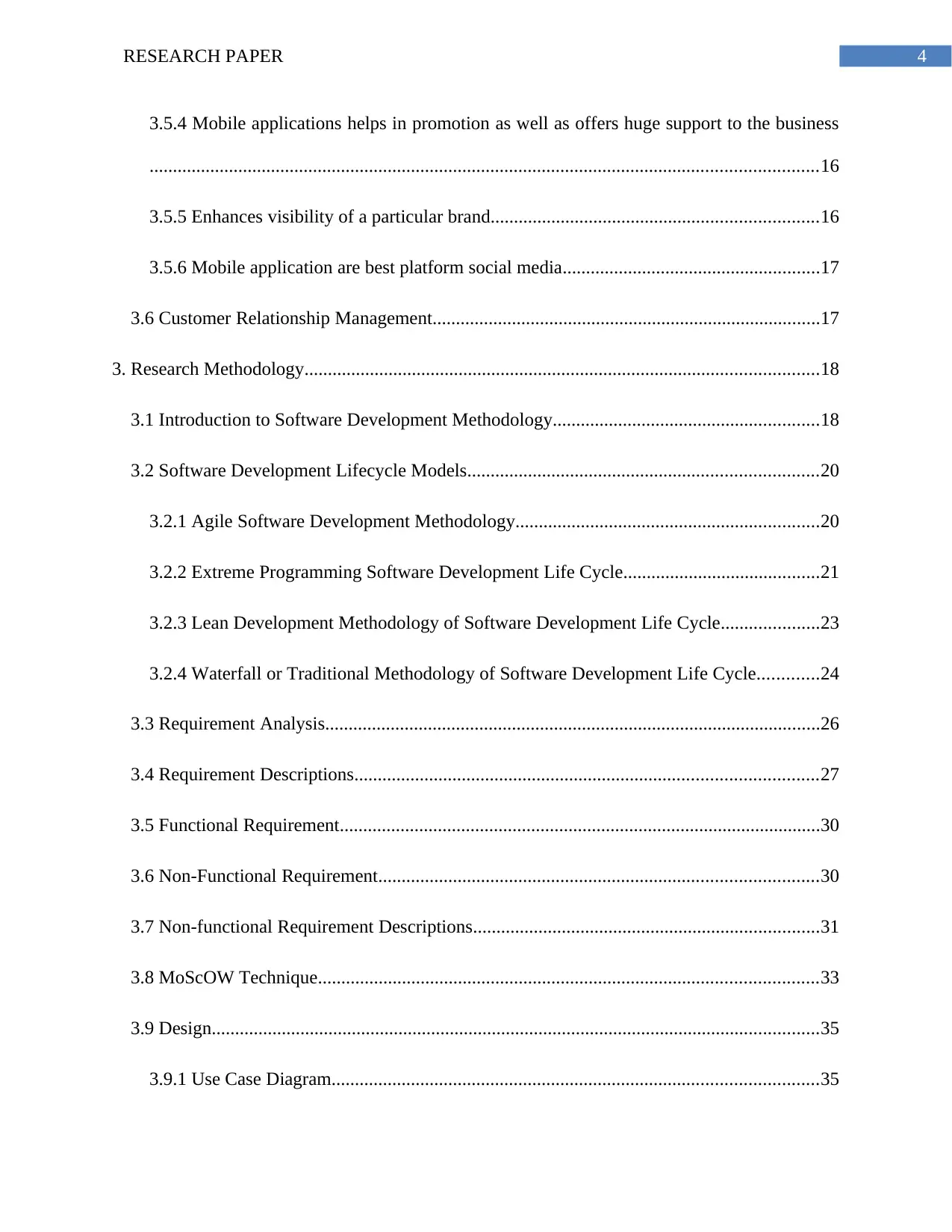
4RESEARCH PAPER
3.5.4 Mobile applications helps in promotion as well as offers huge support to the business
...............................................................................................................................................16
3.5.5 Enhances visibility of a particular brand......................................................................16
3.5.6 Mobile application are best platform social media.......................................................17
3.6 Customer Relationship Management...................................................................................17
3. Research Methodology..............................................................................................................18
3.1 Introduction to Software Development Methodology.........................................................18
3.2 Software Development Lifecycle Models...........................................................................20
3.2.1 Agile Software Development Methodology.................................................................20
3.2.2 Extreme Programming Software Development Life Cycle..........................................21
3.2.3 Lean Development Methodology of Software Development Life Cycle.....................23
3.2.4 Waterfall or Traditional Methodology of Software Development Life Cycle.............24
3.3 Requirement Analysis..........................................................................................................26
3.4 Requirement Descriptions...................................................................................................27
3.5 Functional Requirement.......................................................................................................30
3.6 Non-Functional Requirement..............................................................................................30
3.7 Non-functional Requirement Descriptions..........................................................................31
3.8 MoScOW Technique...........................................................................................................33
3.9 Design..................................................................................................................................35
3.9.1 Use Case Diagram........................................................................................................35
3.5.4 Mobile applications helps in promotion as well as offers huge support to the business
...............................................................................................................................................16
3.5.5 Enhances visibility of a particular brand......................................................................16
3.5.6 Mobile application are best platform social media.......................................................17
3.6 Customer Relationship Management...................................................................................17
3. Research Methodology..............................................................................................................18
3.1 Introduction to Software Development Methodology.........................................................18
3.2 Software Development Lifecycle Models...........................................................................20
3.2.1 Agile Software Development Methodology.................................................................20
3.2.2 Extreme Programming Software Development Life Cycle..........................................21
3.2.3 Lean Development Methodology of Software Development Life Cycle.....................23
3.2.4 Waterfall or Traditional Methodology of Software Development Life Cycle.............24
3.3 Requirement Analysis..........................................................................................................26
3.4 Requirement Descriptions...................................................................................................27
3.5 Functional Requirement.......................................................................................................30
3.6 Non-Functional Requirement..............................................................................................30
3.7 Non-functional Requirement Descriptions..........................................................................31
3.8 MoScOW Technique...........................................................................................................33
3.9 Design..................................................................................................................................35
3.9.1 Use Case Diagram........................................................................................................35
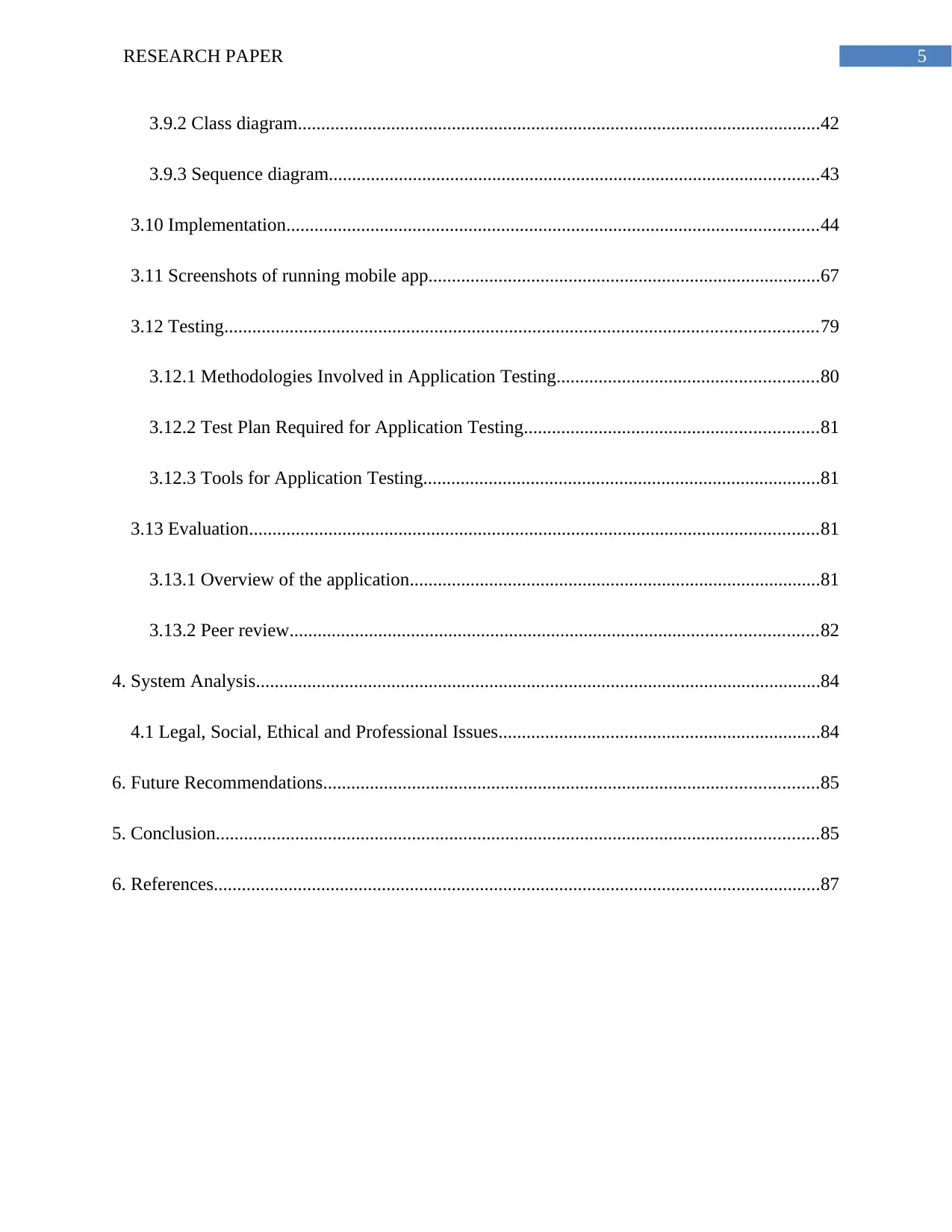
5RESEARCH PAPER
3.9.2 Class diagram................................................................................................................42
3.9.3 Sequence diagram.........................................................................................................43
3.10 Implementation..................................................................................................................44
3.11 Screenshots of running mobile app....................................................................................67
3.12 Testing...............................................................................................................................79
3.12.1 Methodologies Involved in Application Testing........................................................80
3.12.2 Test Plan Required for Application Testing...............................................................81
3.12.3 Tools for Application Testing.....................................................................................81
3.13 Evaluation..........................................................................................................................81
3.13.1 Overview of the application........................................................................................81
3.13.2 Peer review.................................................................................................................82
4. System Analysis.........................................................................................................................84
4.1 Legal, Social, Ethical and Professional Issues.....................................................................84
6. Future Recommendations..........................................................................................................85
5. Conclusion.................................................................................................................................85
6. References..................................................................................................................................87
3.9.2 Class diagram................................................................................................................42
3.9.3 Sequence diagram.........................................................................................................43
3.10 Implementation..................................................................................................................44
3.11 Screenshots of running mobile app....................................................................................67
3.12 Testing...............................................................................................................................79
3.12.1 Methodologies Involved in Application Testing........................................................80
3.12.2 Test Plan Required for Application Testing...............................................................81
3.12.3 Tools for Application Testing.....................................................................................81
3.13 Evaluation..........................................................................................................................81
3.13.1 Overview of the application........................................................................................81
3.13.2 Peer review.................................................................................................................82
4. System Analysis.........................................................................................................................84
4.1 Legal, Social, Ethical and Professional Issues.....................................................................84
6. Future Recommendations..........................................................................................................85
5. Conclusion.................................................................................................................................85
6. References..................................................................................................................................87
⊘ This is a preview!⊘
Do you want full access?
Subscribe today to unlock all pages.

Trusted by 1+ million students worldwide

6RESEARCH PAPER
Table of Figures
Figure 1: Activity Cycle of Android..............................................................................................14
Figure 2: Agile Methodology of SDLC.........................................................................................21
Figure 3: Extreme Programming Methodology of SDLC.............................................................22
Figure 4: Lean Development Methodology of SDLC...................................................................23
Figure 5: Waterfall Development Methodology of SDLC............................................................25
Figure 6: Use Case Diagram of User End.....................................................................................35
Figure 7: Use Case Diagram of Admin End..................................................................................41
Figure 8: Class Diagram of Mobile Application...........................................................................42
Figure 9: Sequence Diagram for the MyStationaryApp................................................................43
Figure 10: MainAcitivty layout.....................................................................................................56
Figure 11: MainAcitivty java 1......................................................................................................56
Figure 12: MainAcitivty java 2......................................................................................................57
Figure 13: MainAcitivty java 3......................................................................................................57
Figure 14: Items Activity Layout..................................................................................................58
Figure 15: Items Activity Java 1....................................................................................................58
Figure 16: Items Activity Java 2....................................................................................................59
Figure 17: Items Activity Java 2....................................................................................................59
Figure 18: Items Activity Java 2....................................................................................................60
Figure 19: Cart Activity Layout 1.................................................................................................60
Figure 20: Cart Activity Layout 2.................................................................................................61
Figure 21: Cart Activity Layout 3.................................................................................................61
Figure 22: Cart Activity Layout 4.................................................................................................62
Table of Figures
Figure 1: Activity Cycle of Android..............................................................................................14
Figure 2: Agile Methodology of SDLC.........................................................................................21
Figure 3: Extreme Programming Methodology of SDLC.............................................................22
Figure 4: Lean Development Methodology of SDLC...................................................................23
Figure 5: Waterfall Development Methodology of SDLC............................................................25
Figure 6: Use Case Diagram of User End.....................................................................................35
Figure 7: Use Case Diagram of Admin End..................................................................................41
Figure 8: Class Diagram of Mobile Application...........................................................................42
Figure 9: Sequence Diagram for the MyStationaryApp................................................................43
Figure 10: MainAcitivty layout.....................................................................................................56
Figure 11: MainAcitivty java 1......................................................................................................56
Figure 12: MainAcitivty java 2......................................................................................................57
Figure 13: MainAcitivty java 3......................................................................................................57
Figure 14: Items Activity Layout..................................................................................................58
Figure 15: Items Activity Java 1....................................................................................................58
Figure 16: Items Activity Java 2....................................................................................................59
Figure 17: Items Activity Java 2....................................................................................................59
Figure 18: Items Activity Java 2....................................................................................................60
Figure 19: Cart Activity Layout 1.................................................................................................60
Figure 20: Cart Activity Layout 2.................................................................................................61
Figure 21: Cart Activity Layout 3.................................................................................................61
Figure 22: Cart Activity Layout 4.................................................................................................62
Paraphrase This Document
Need a fresh take? Get an instant paraphrase of this document with our AI Paraphraser
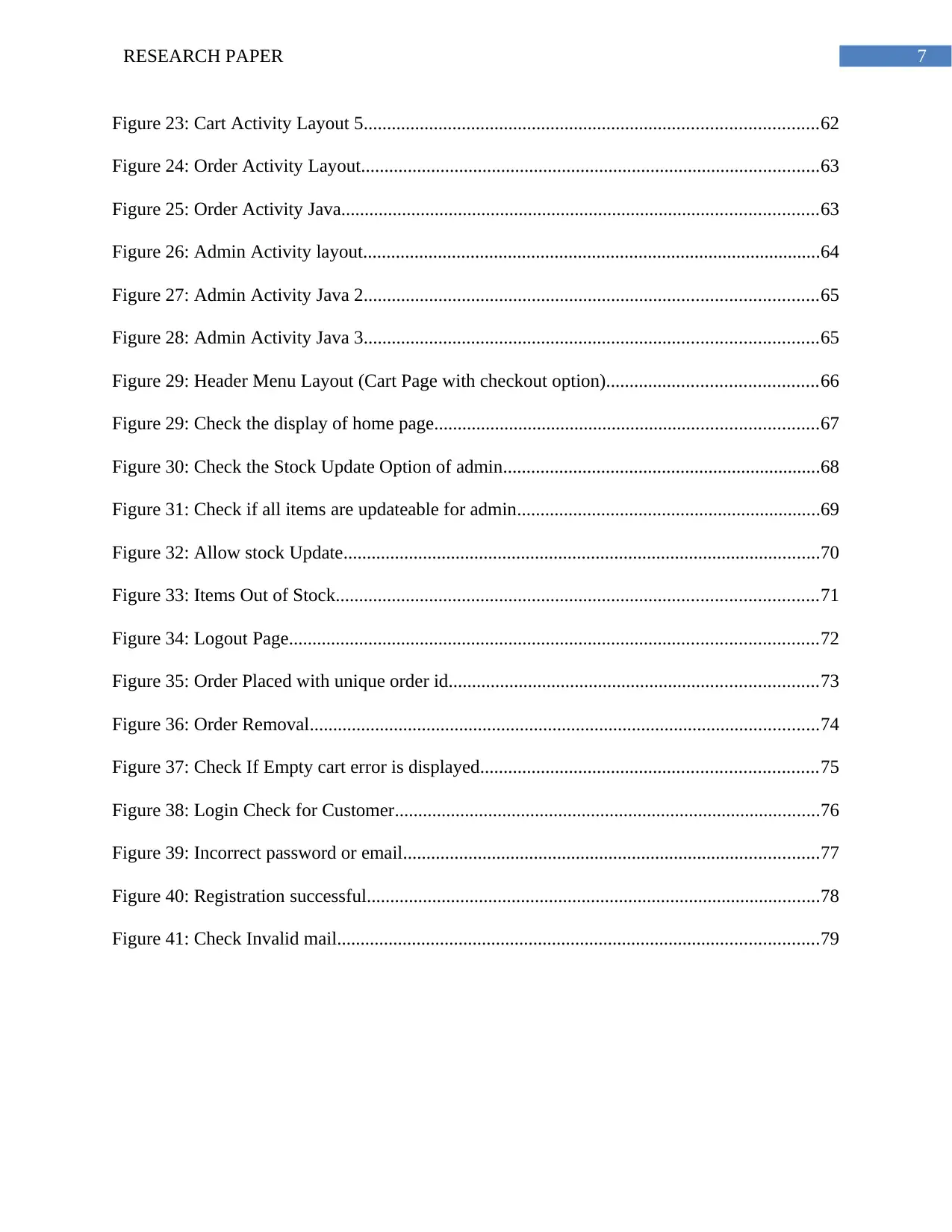
7RESEARCH PAPER
Figure 23: Cart Activity Layout 5.................................................................................................62
Figure 24: Order Activity Layout..................................................................................................63
Figure 25: Order Activity Java......................................................................................................63
Figure 26: Admin Activity layout..................................................................................................64
Figure 27: Admin Activity Java 2.................................................................................................65
Figure 28: Admin Activity Java 3.................................................................................................65
Figure 29: Header Menu Layout (Cart Page with checkout option).............................................66
Figure 29: Check the display of home page..................................................................................67
Figure 30: Check the Stock Update Option of admin....................................................................68
Figure 31: Check if all items are updateable for admin.................................................................69
Figure 32: Allow stock Update......................................................................................................70
Figure 33: Items Out of Stock.......................................................................................................71
Figure 34: Logout Page.................................................................................................................72
Figure 35: Order Placed with unique order id...............................................................................73
Figure 36: Order Removal.............................................................................................................74
Figure 37: Check If Empty cart error is displayed........................................................................75
Figure 38: Login Check for Customer...........................................................................................76
Figure 39: Incorrect password or email.........................................................................................77
Figure 40: Registration successful.................................................................................................78
Figure 41: Check Invalid mail.......................................................................................................79
Figure 23: Cart Activity Layout 5.................................................................................................62
Figure 24: Order Activity Layout..................................................................................................63
Figure 25: Order Activity Java......................................................................................................63
Figure 26: Admin Activity layout..................................................................................................64
Figure 27: Admin Activity Java 2.................................................................................................65
Figure 28: Admin Activity Java 3.................................................................................................65
Figure 29: Header Menu Layout (Cart Page with checkout option).............................................66
Figure 29: Check the display of home page..................................................................................67
Figure 30: Check the Stock Update Option of admin....................................................................68
Figure 31: Check if all items are updateable for admin.................................................................69
Figure 32: Allow stock Update......................................................................................................70
Figure 33: Items Out of Stock.......................................................................................................71
Figure 34: Logout Page.................................................................................................................72
Figure 35: Order Placed with unique order id...............................................................................73
Figure 36: Order Removal.............................................................................................................74
Figure 37: Check If Empty cart error is displayed........................................................................75
Figure 38: Login Check for Customer...........................................................................................76
Figure 39: Incorrect password or email.........................................................................................77
Figure 40: Registration successful.................................................................................................78
Figure 41: Check Invalid mail.......................................................................................................79

8RESEARCH PAPER
Table of Tables
Table 1: The user rate statistics of the Android versions...............................................................24
Table 2: Use case of “Add items to cart”......................................................................................29
Table 3: Use case of “Customer Sign Up”....................................................................................30
Table 4: Use case of “Product categories and items”....................................................................31
Table 6: The user rate statistics of the Android versions...............................................................33
Table of Tables
Table 1: The user rate statistics of the Android versions...............................................................24
Table 2: Use case of “Add items to cart”......................................................................................29
Table 3: Use case of “Customer Sign Up”....................................................................................30
Table 4: Use case of “Product categories and items”....................................................................31
Table 6: The user rate statistics of the Android versions...............................................................33
⊘ This is a preview!⊘
Do you want full access?
Subscribe today to unlock all pages.

Trusted by 1+ million students worldwide
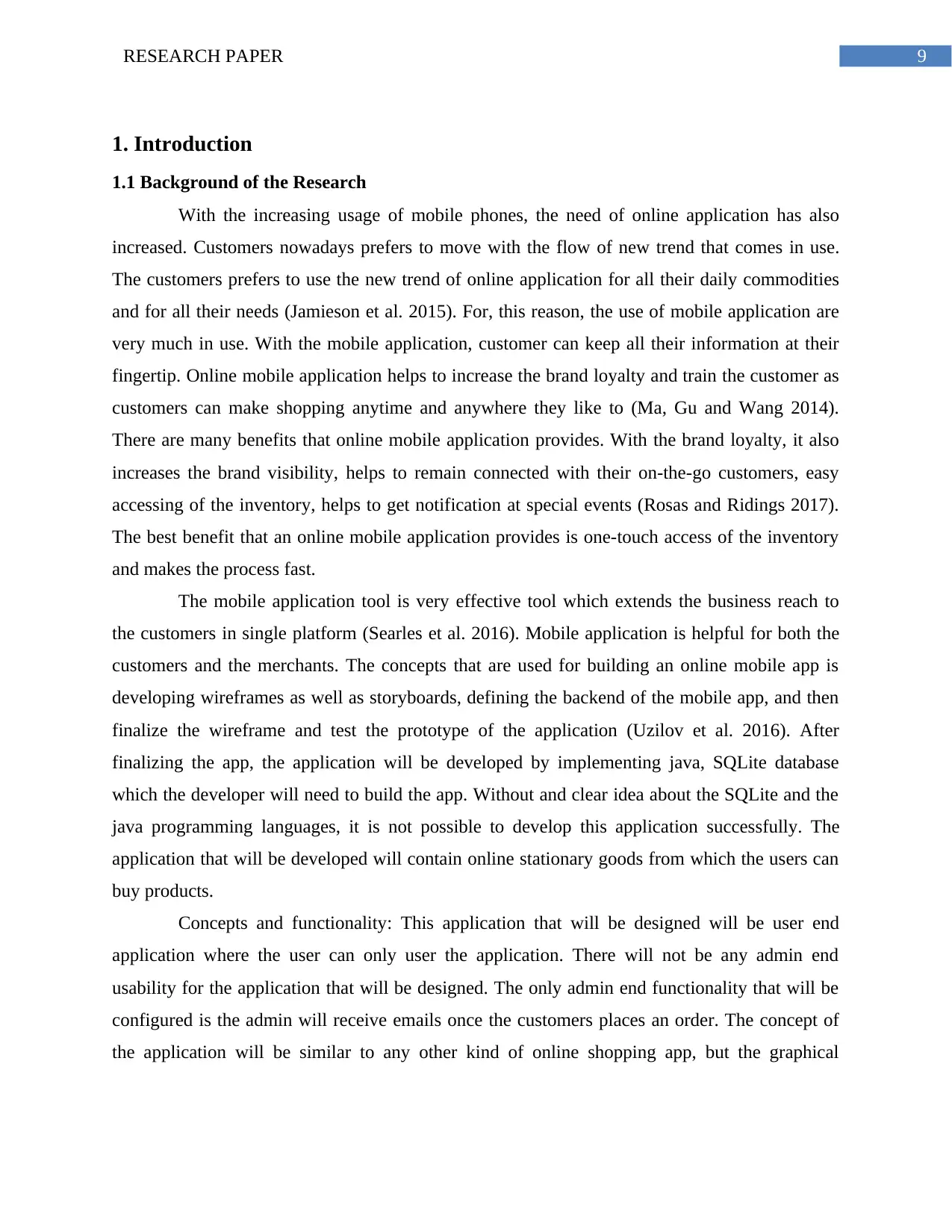
9RESEARCH PAPER
1. Introduction
1.1 Background of the Research
With the increasing usage of mobile phones, the need of online application has also
increased. Customers nowadays prefers to move with the flow of new trend that comes in use.
The customers prefers to use the new trend of online application for all their daily commodities
and for all their needs (Jamieson et al. 2015). For, this reason, the use of mobile application are
very much in use. With the mobile application, customer can keep all their information at their
fingertip. Online mobile application helps to increase the brand loyalty and train the customer as
customers can make shopping anytime and anywhere they like to (Ma, Gu and Wang 2014).
There are many benefits that online mobile application provides. With the brand loyalty, it also
increases the brand visibility, helps to remain connected with their on-the-go customers, easy
accessing of the inventory, helps to get notification at special events (Rosas and Ridings 2017).
The best benefit that an online mobile application provides is one-touch access of the inventory
and makes the process fast.
The mobile application tool is very effective tool which extends the business reach to
the customers in single platform (Searles et al. 2016). Mobile application is helpful for both the
customers and the merchants. The concepts that are used for building an online mobile app is
developing wireframes as well as storyboards, defining the backend of the mobile app, and then
finalize the wireframe and test the prototype of the application (Uzilov et al. 2016). After
finalizing the app, the application will be developed by implementing java, SQLite database
which the developer will need to build the app. Without and clear idea about the SQLite and the
java programming languages, it is not possible to develop this application successfully. The
application that will be developed will contain online stationary goods from which the users can
buy products.
Concepts and functionality: This application that will be designed will be user end
application where the user can only user the application. There will not be any admin end
usability for the application that will be designed. The only admin end functionality that will be
configured is the admin will receive emails once the customers places an order. The concept of
the application will be similar to any other kind of online shopping app, but the graphical
1. Introduction
1.1 Background of the Research
With the increasing usage of mobile phones, the need of online application has also
increased. Customers nowadays prefers to move with the flow of new trend that comes in use.
The customers prefers to use the new trend of online application for all their daily commodities
and for all their needs (Jamieson et al. 2015). For, this reason, the use of mobile application are
very much in use. With the mobile application, customer can keep all their information at their
fingertip. Online mobile application helps to increase the brand loyalty and train the customer as
customers can make shopping anytime and anywhere they like to (Ma, Gu and Wang 2014).
There are many benefits that online mobile application provides. With the brand loyalty, it also
increases the brand visibility, helps to remain connected with their on-the-go customers, easy
accessing of the inventory, helps to get notification at special events (Rosas and Ridings 2017).
The best benefit that an online mobile application provides is one-touch access of the inventory
and makes the process fast.
The mobile application tool is very effective tool which extends the business reach to
the customers in single platform (Searles et al. 2016). Mobile application is helpful for both the
customers and the merchants. The concepts that are used for building an online mobile app is
developing wireframes as well as storyboards, defining the backend of the mobile app, and then
finalize the wireframe and test the prototype of the application (Uzilov et al. 2016). After
finalizing the app, the application will be developed by implementing java, SQLite database
which the developer will need to build the app. Without and clear idea about the SQLite and the
java programming languages, it is not possible to develop this application successfully. The
application that will be developed will contain online stationary goods from which the users can
buy products.
Concepts and functionality: This application that will be designed will be user end
application where the user can only user the application. There will not be any admin end
usability for the application that will be designed. The only admin end functionality that will be
configured is the admin will receive emails once the customers places an order. The concept of
the application will be similar to any other kind of online shopping app, but the graphical
Paraphrase This Document
Need a fresh take? Get an instant paraphrase of this document with our AI Paraphraser

10RESEARCH PAPER
resources of the application will be highly compressed. This will take very less time to compress
and can be loaded with low internet connectivity.
Algorithms: The algorithms that will be used while developing this application is linear
search algorithm, where the customers can search the products in the app. Also, sorting
algorithms will be used that will help the customers to filter their choices according to their
demand.
1.2 Scope of the Research
This application that will be designed will be user end application as well as admin end
application where the user can use the application for buying stationary goods online and the
admin can manage the products that are to be sold through the application. The admin will also
receive emails once the customer places an order and the admin will work accordingly. The
concept of the application will be similar to any other kind of online shopping app, but the
graphical resources of the application will be highly compressed. This will take very less time to
compress and can be loaded with low internet connectivity.
This project aims to develop an online shopping app which the users can use for buying
online stationary products. The application that is intended is an online app for buying of
stationary products. The application planned will be designed by keeping the security of the data
involved in the application. The application is secured by using the encryption process and
implementing SQL Injection. This project of designing the application is carried out in different
phases. Firstly, the project should be analyzed, then application should be designed and
developed. After designing and developing the application, there is testing phase and after the
testing is completed, the application is then evaluated.
1.3 Aim and Objectives
The main aim of this research paper is to build an interface where the users using the
application can do online shopping from the application without security and data breach risks.
With this online buying shopping application, the user feels very reluctant while using this
application as the risks factors related with the application are secured by encryption process and
implementing SQL Injection while developing the application (Meerscheet al. 2016). For making
this product, mainly five phases are carried out that includes analyzing the project, designing the
application, developing the application and finally evaluating them.
resources of the application will be highly compressed. This will take very less time to compress
and can be loaded with low internet connectivity.
Algorithms: The algorithms that will be used while developing this application is linear
search algorithm, where the customers can search the products in the app. Also, sorting
algorithms will be used that will help the customers to filter their choices according to their
demand.
1.2 Scope of the Research
This application that will be designed will be user end application as well as admin end
application where the user can use the application for buying stationary goods online and the
admin can manage the products that are to be sold through the application. The admin will also
receive emails once the customer places an order and the admin will work accordingly. The
concept of the application will be similar to any other kind of online shopping app, but the
graphical resources of the application will be highly compressed. This will take very less time to
compress and can be loaded with low internet connectivity.
This project aims to develop an online shopping app which the users can use for buying
online stationary products. The application that is intended is an online app for buying of
stationary products. The application planned will be designed by keeping the security of the data
involved in the application. The application is secured by using the encryption process and
implementing SQL Injection. This project of designing the application is carried out in different
phases. Firstly, the project should be analyzed, then application should be designed and
developed. After designing and developing the application, there is testing phase and after the
testing is completed, the application is then evaluated.
1.3 Aim and Objectives
The main aim of this research paper is to build an interface where the users using the
application can do online shopping from the application without security and data breach risks.
With this online buying shopping application, the user feels very reluctant while using this
application as the risks factors related with the application are secured by encryption process and
implementing SQL Injection while developing the application (Meerscheet al. 2016). For making
this product, mainly five phases are carried out that includes analyzing the project, designing the
application, developing the application and finally evaluating them.

11RESEARCH PAPER
The objectives that are stated for this research paper are SMART that includes specific,
measureable, actionable, relevant as well as time bounding to the research study. The objectives
of this research paper is stated below:
To build an application that fulfills the aim of this research project.
To make a user friendly application through which the user can easily buy online
stationary via this application.
To investigate system modelling and design that helps in software development of the
online shopping application.
To test whether the online shopping application works well as per the requirement of the
users.
To overcome the security risks and management risks related with developing of
application and ways to mitigate those risks.
To make the application cost effective which will save the money of the user and the
seller as well.
1.4 Research Questions
How to make the application user friendly which will help the user to buy easily online
stationary with this app?
How to test whether the online shopping application is working well as per the
requirement of the users?
What are the system modelling and designs used software development of the
application?
What are the risks associated with the application and how to overcome the risks
associated?
Why people and businesses prefer mobile app over website?
Why mobile app is more convenient than website?
What are the Advantages of this mobile app for my client?
Comparison between mobile app and Responsive website.
How to attract more customer through mobile app?
1.5 Summary
For building the application of online shopping, proper designing, with proper
requirements are to be set first. For developing the app, the developer must firstly clear all the
The objectives that are stated for this research paper are SMART that includes specific,
measureable, actionable, relevant as well as time bounding to the research study. The objectives
of this research paper is stated below:
To build an application that fulfills the aim of this research project.
To make a user friendly application through which the user can easily buy online
stationary via this application.
To investigate system modelling and design that helps in software development of the
online shopping application.
To test whether the online shopping application works well as per the requirement of the
users.
To overcome the security risks and management risks related with developing of
application and ways to mitigate those risks.
To make the application cost effective which will save the money of the user and the
seller as well.
1.4 Research Questions
How to make the application user friendly which will help the user to buy easily online
stationary with this app?
How to test whether the online shopping application is working well as per the
requirement of the users?
What are the system modelling and designs used software development of the
application?
What are the risks associated with the application and how to overcome the risks
associated?
Why people and businesses prefer mobile app over website?
Why mobile app is more convenient than website?
What are the Advantages of this mobile app for my client?
Comparison between mobile app and Responsive website.
How to attract more customer through mobile app?
1.5 Summary
For building the application of online shopping, proper designing, with proper
requirements are to be set first. For developing the app, the developer must firstly clear all the
⊘ This is a preview!⊘
Do you want full access?
Subscribe today to unlock all pages.

Trusted by 1+ million students worldwide
1 out of 89
Related Documents
Your All-in-One AI-Powered Toolkit for Academic Success.
+13062052269
info@desklib.com
Available 24*7 on WhatsApp / Email
![[object Object]](/_next/static/media/star-bottom.7253800d.svg)
Unlock your academic potential
Copyright © 2020–2025 A2Z Services. All Rights Reserved. Developed and managed by ZUCOL.



